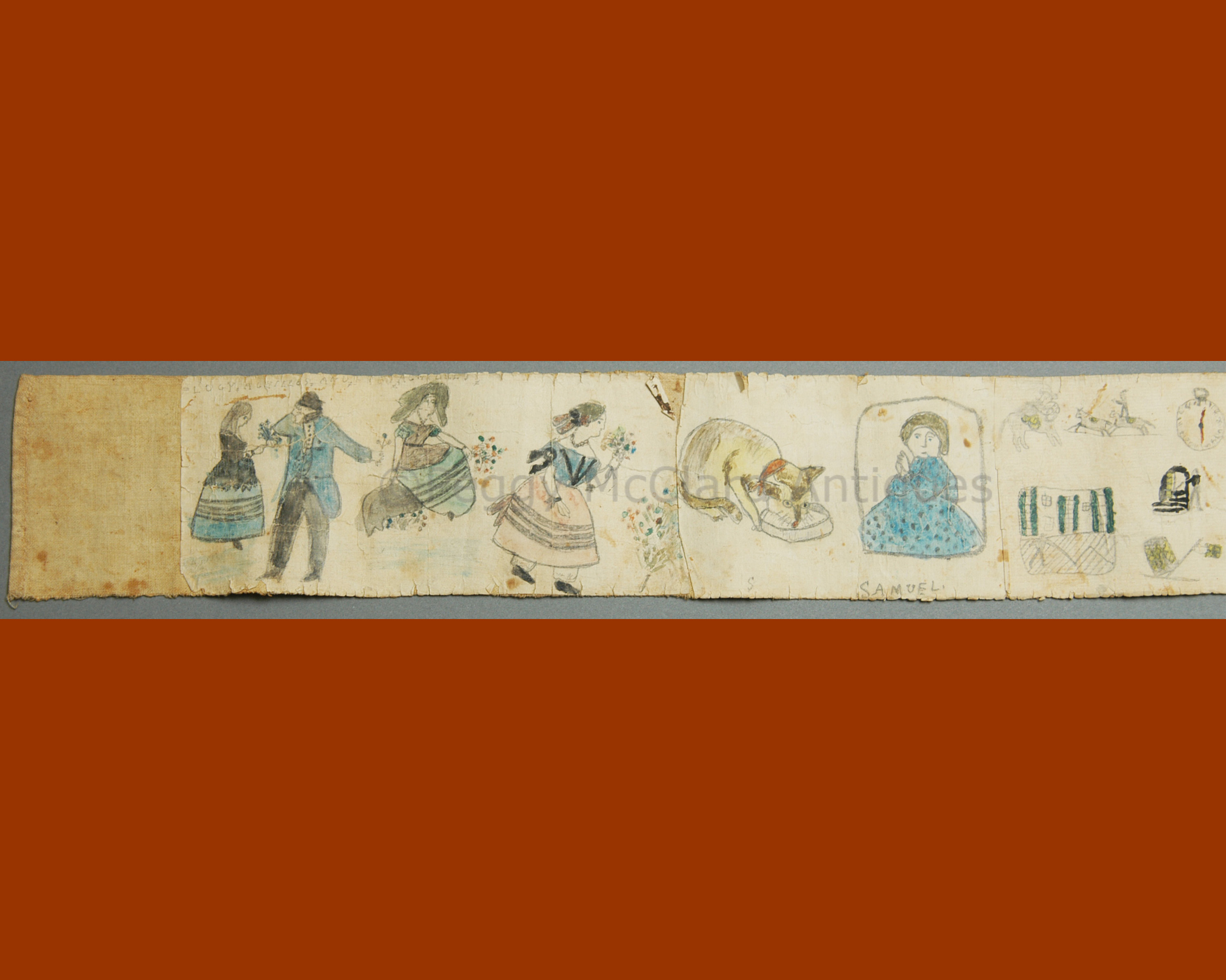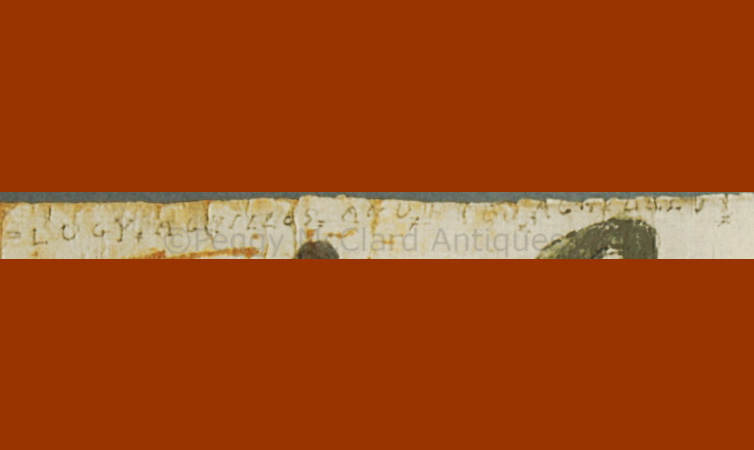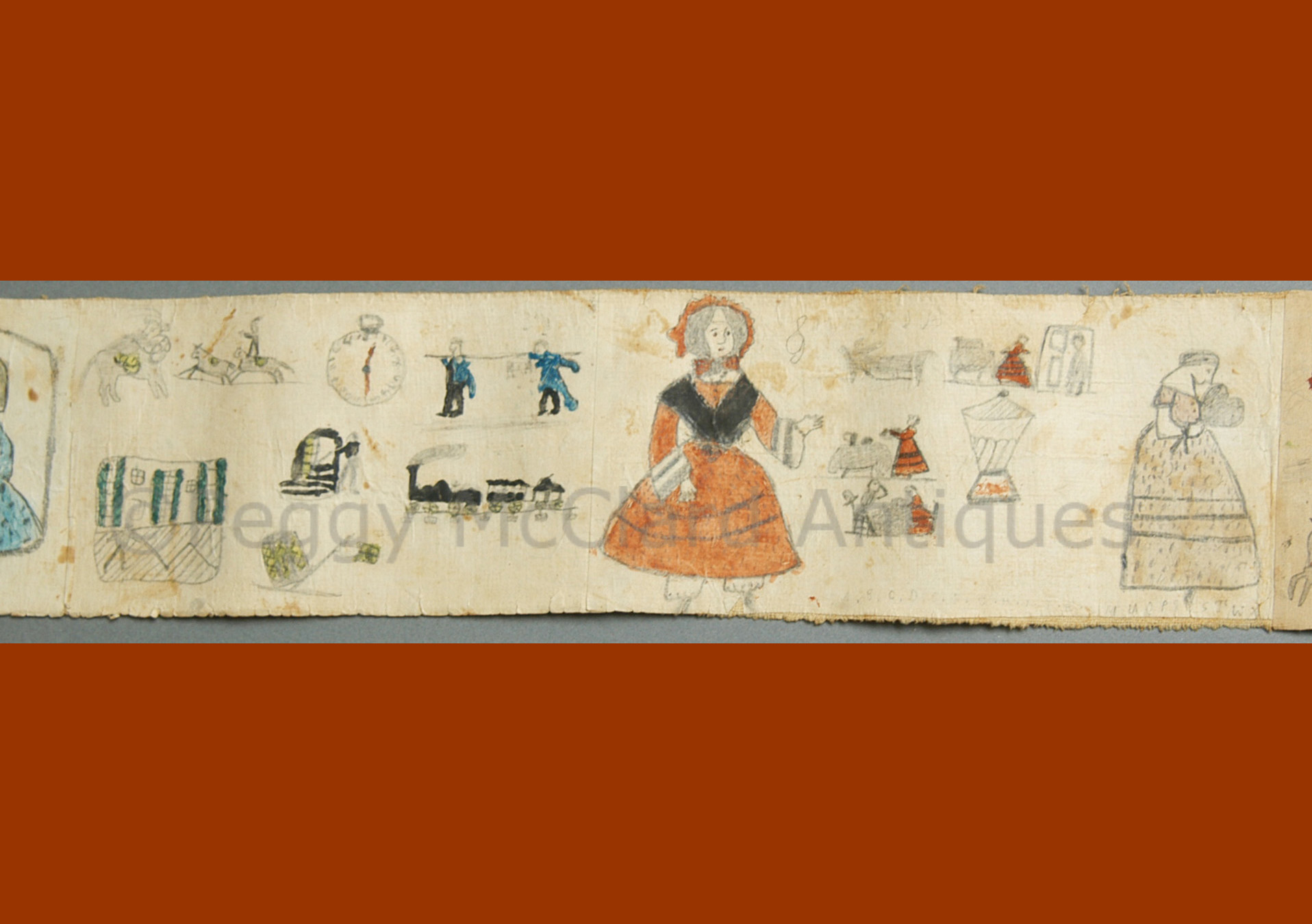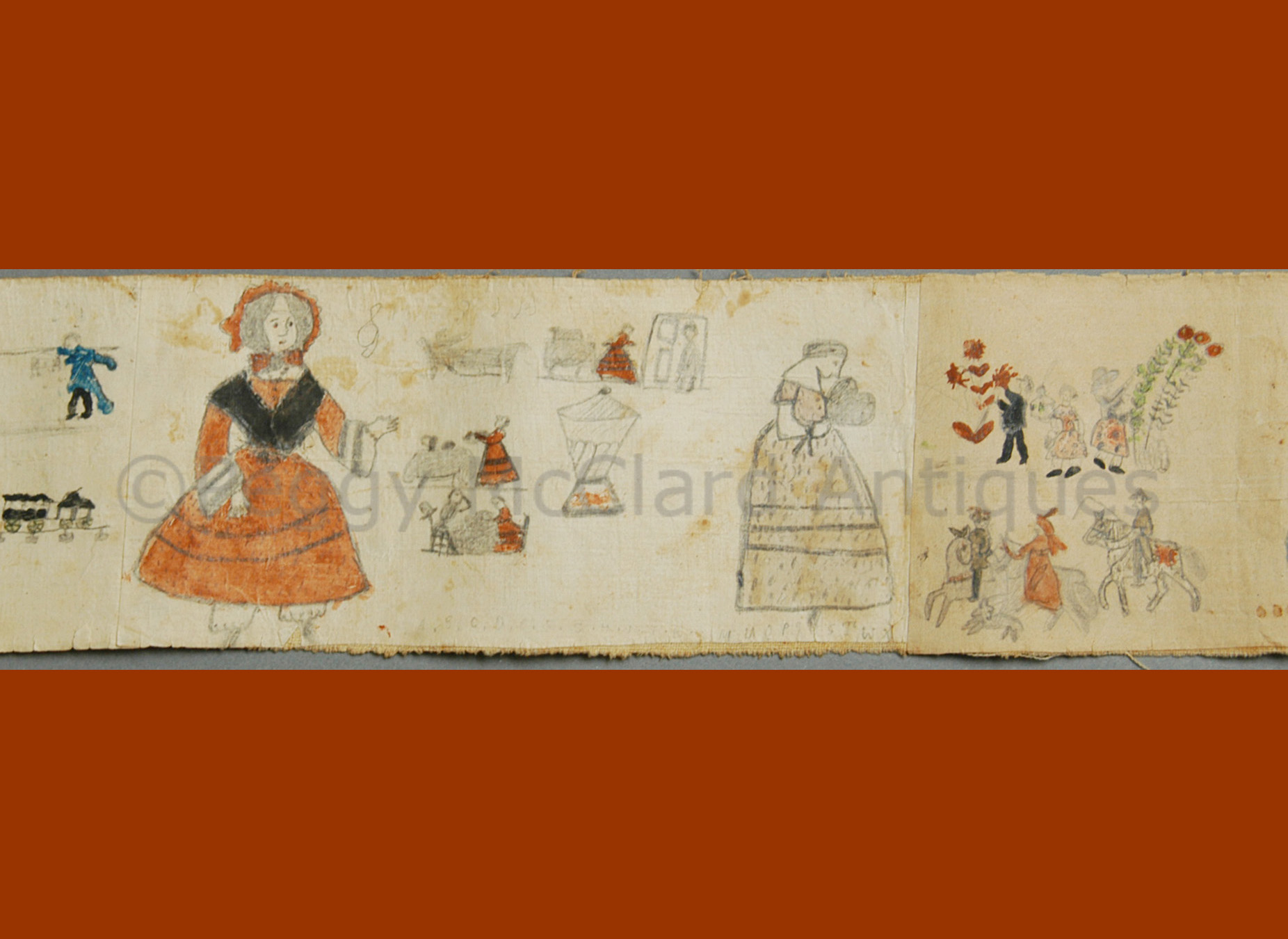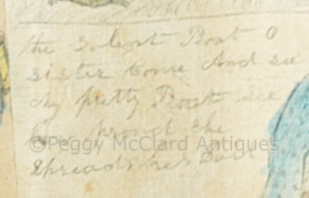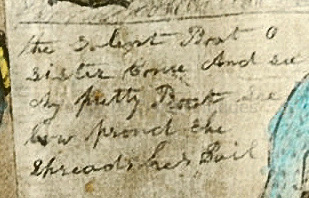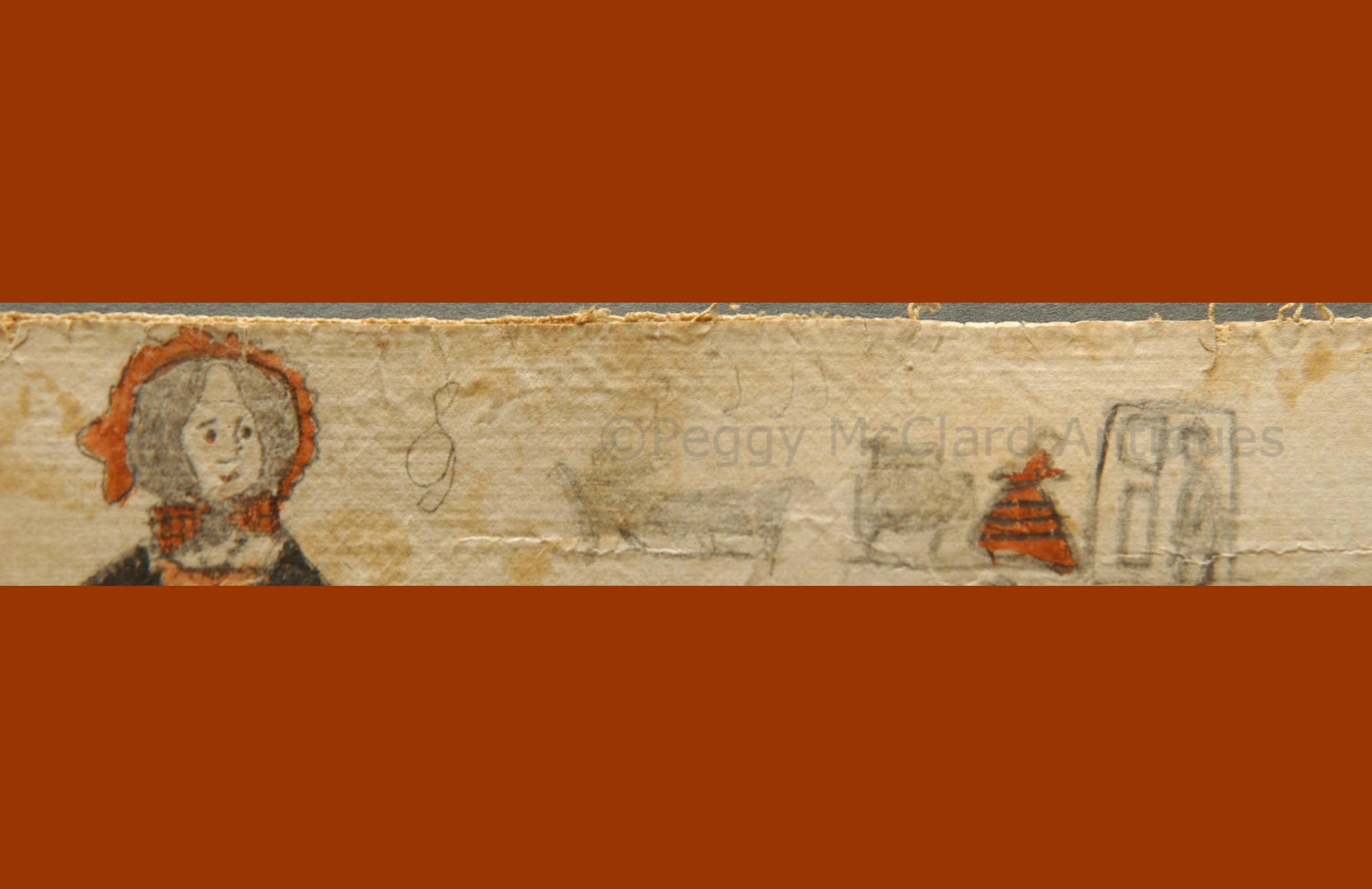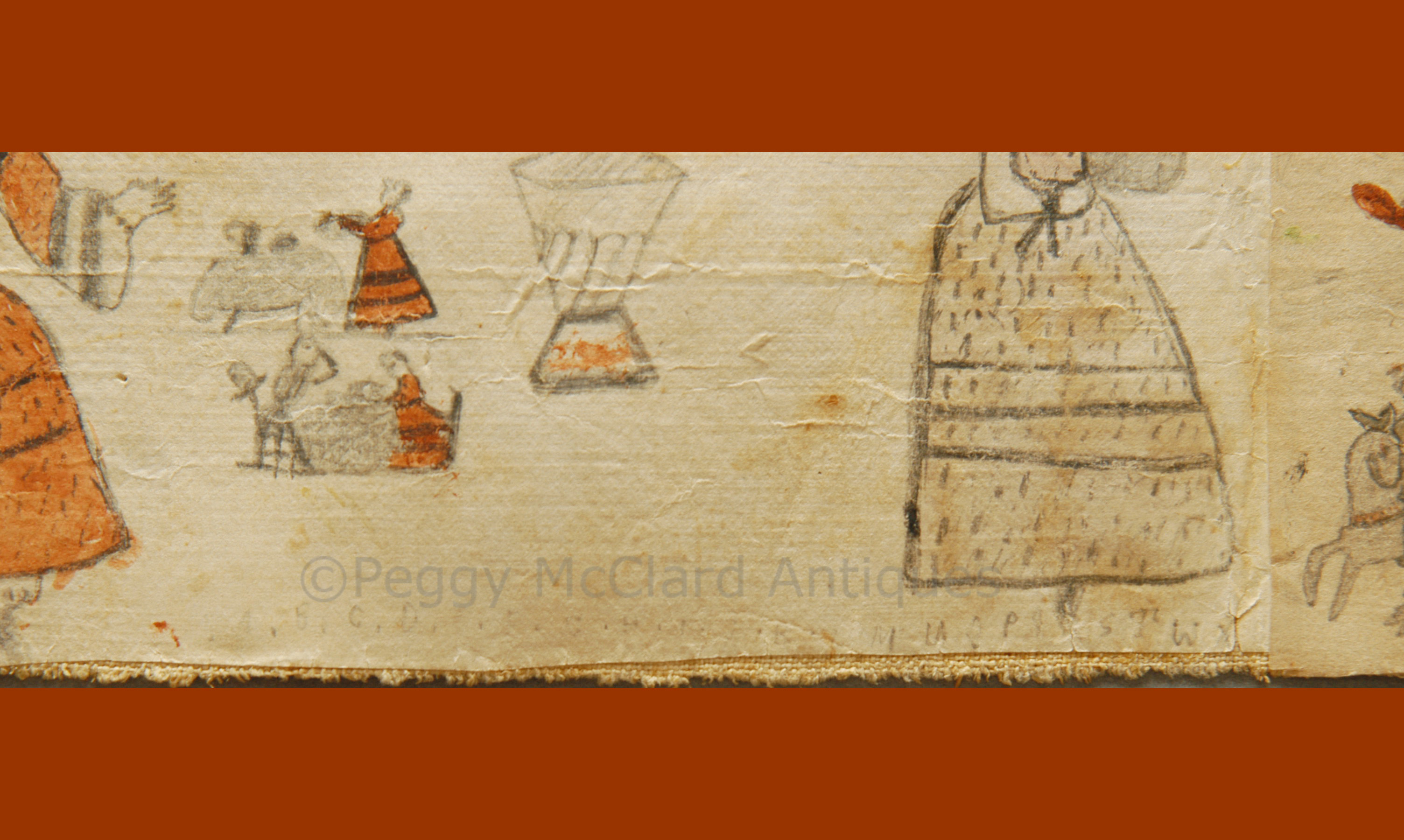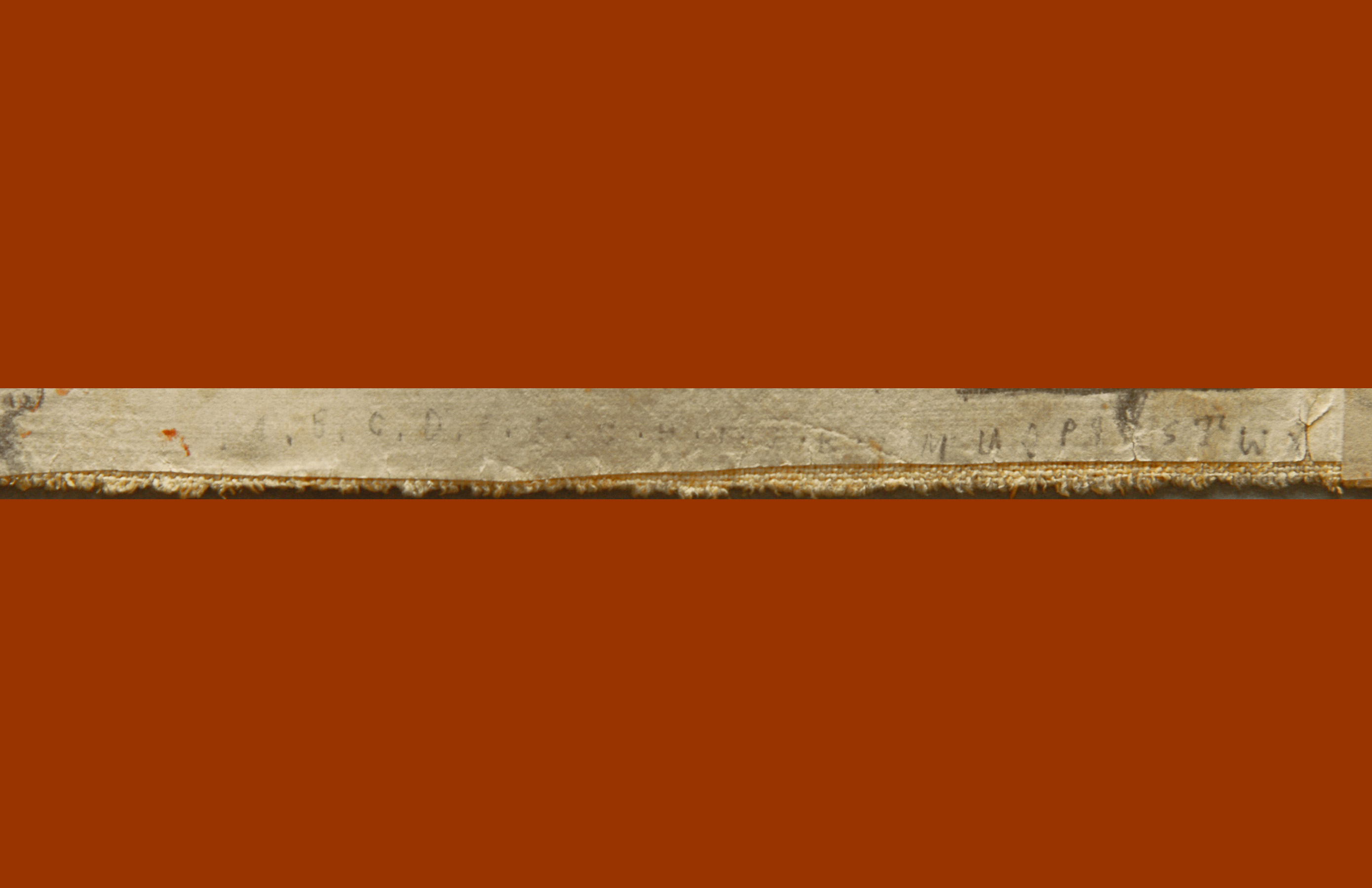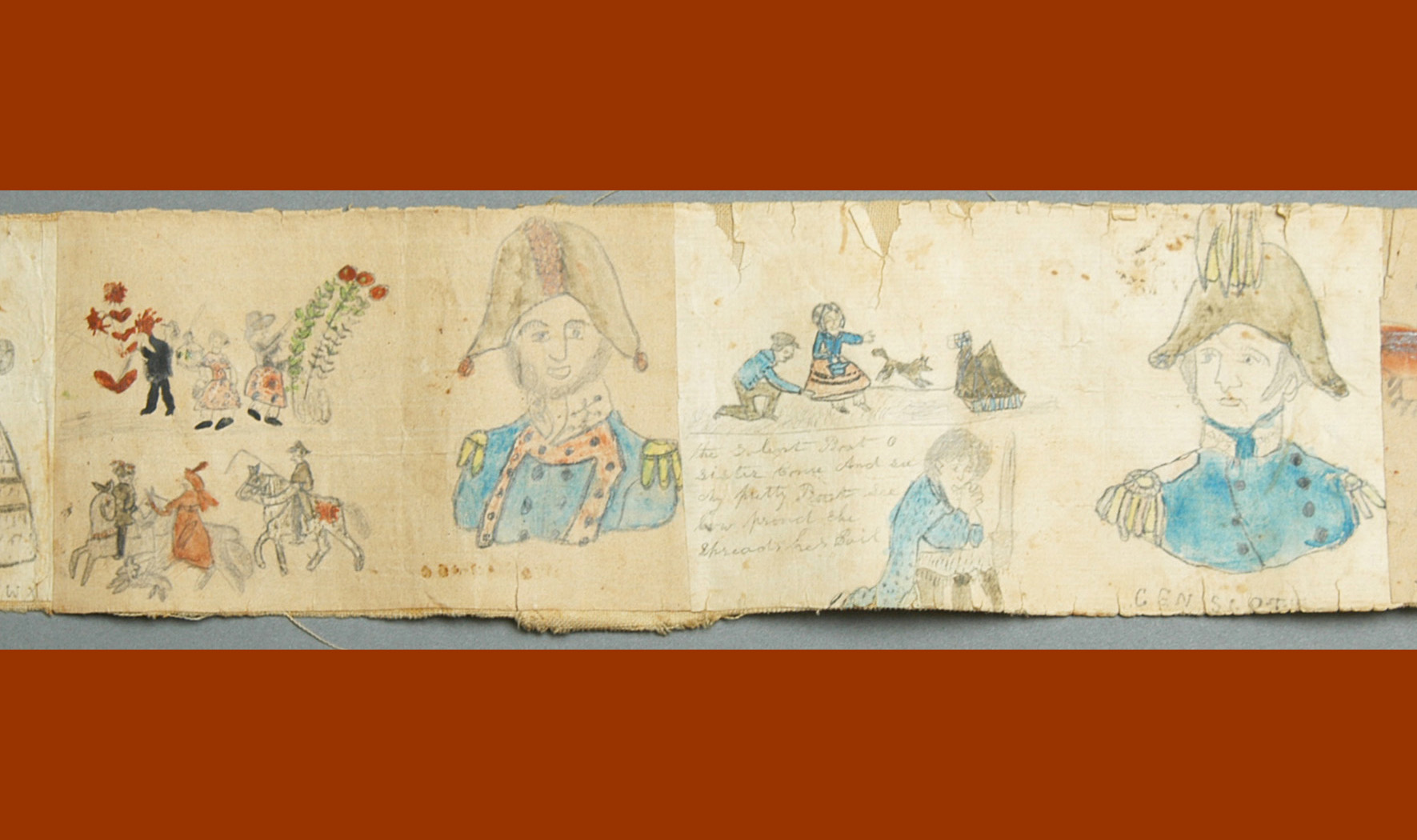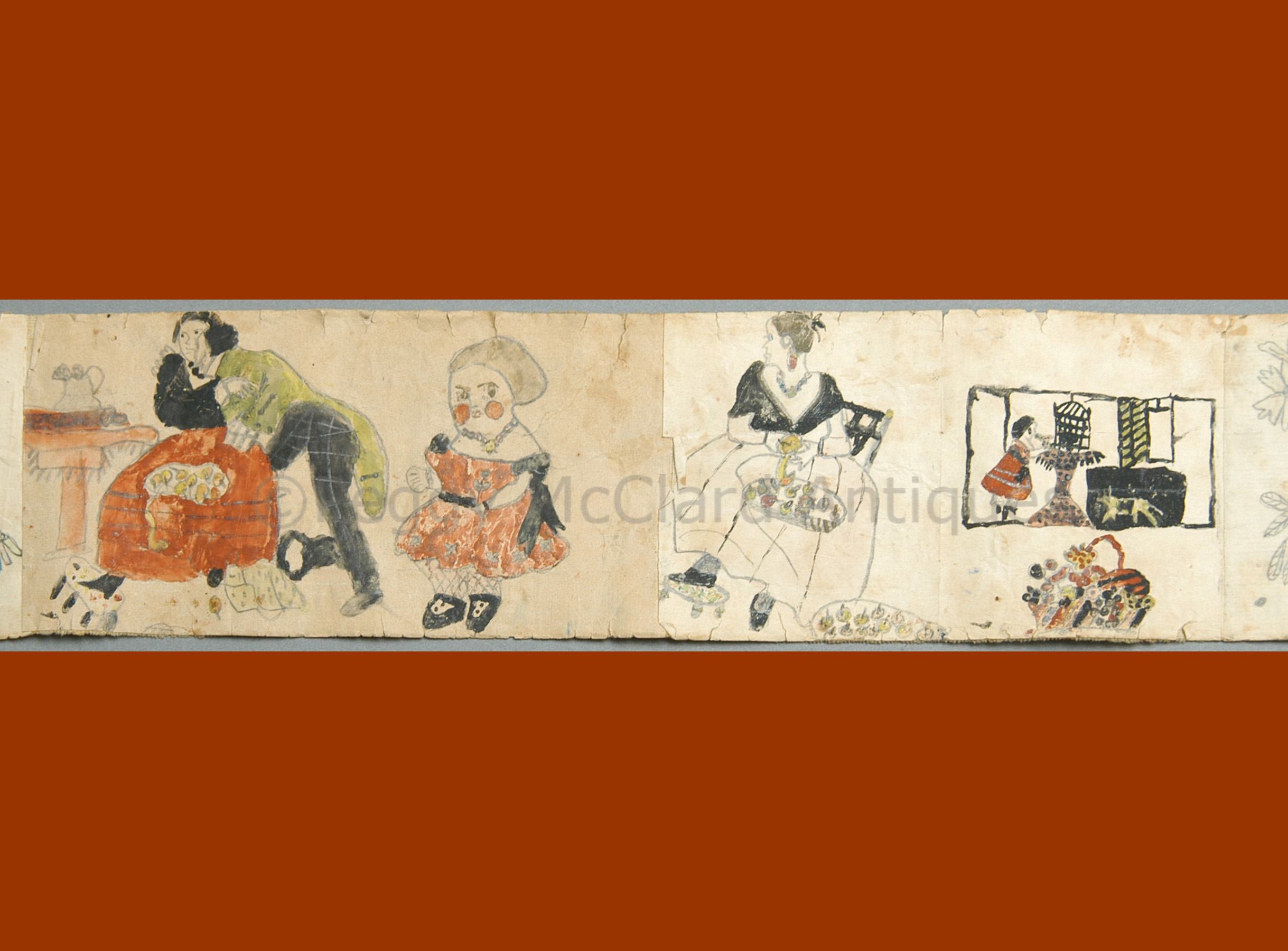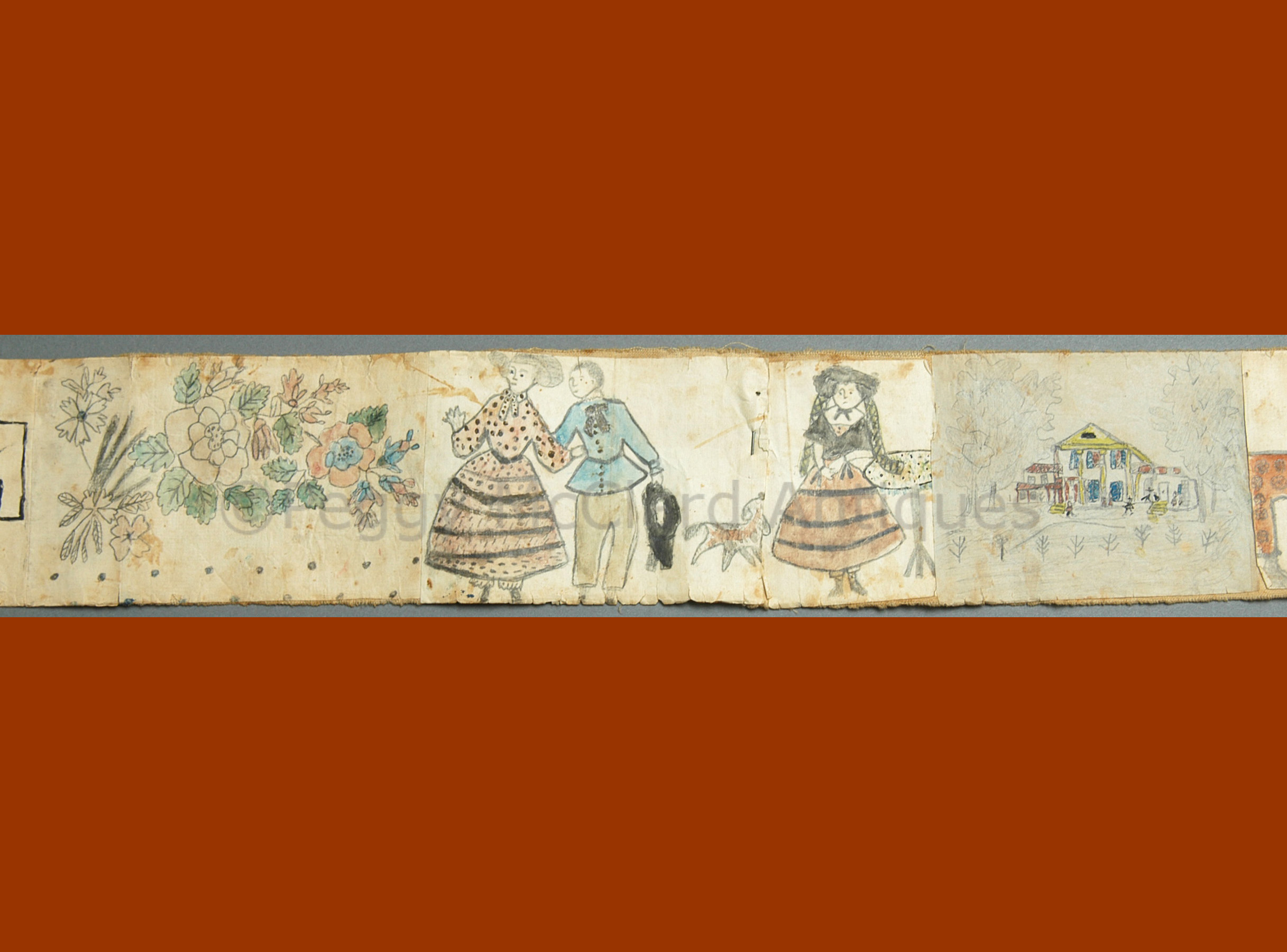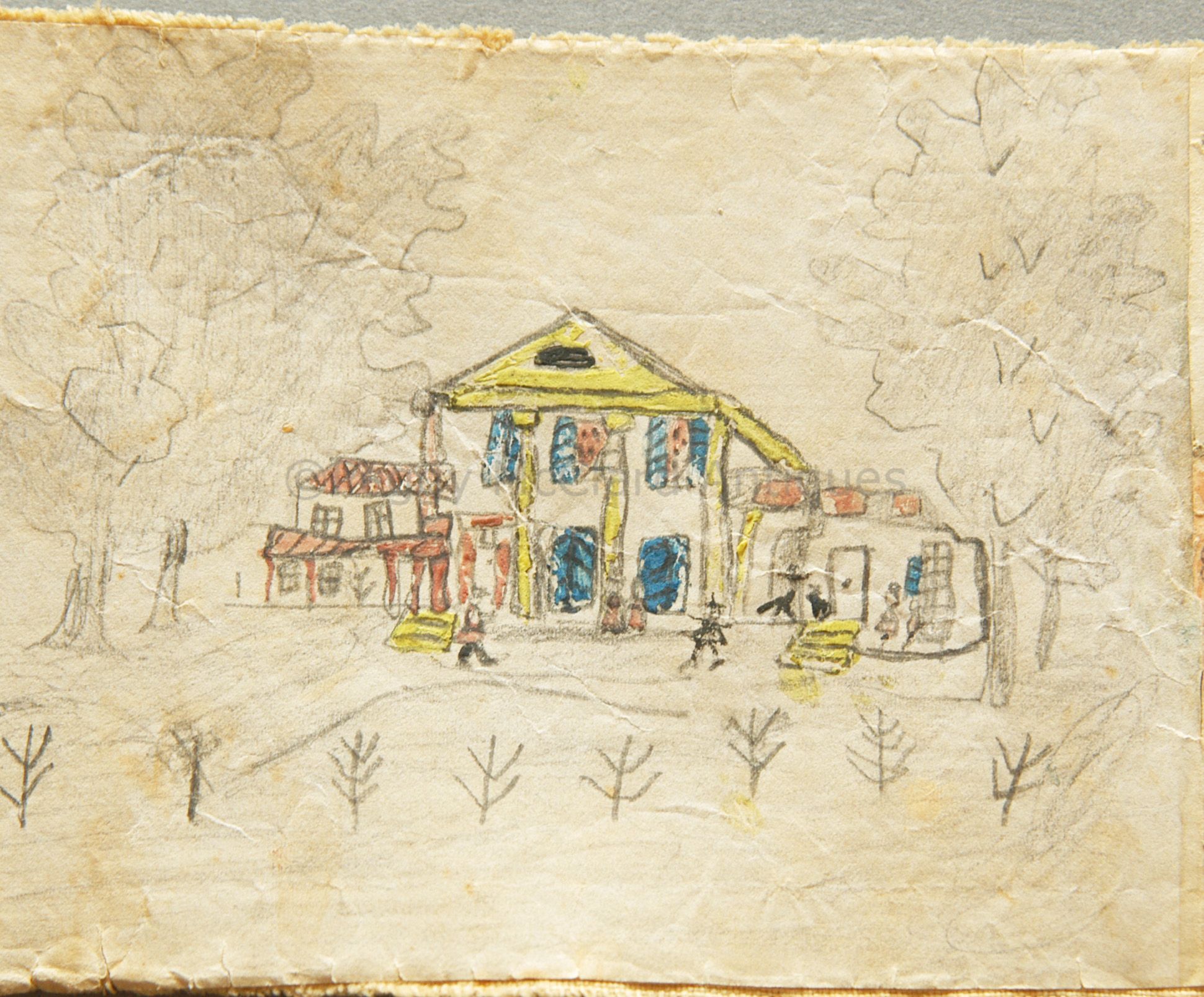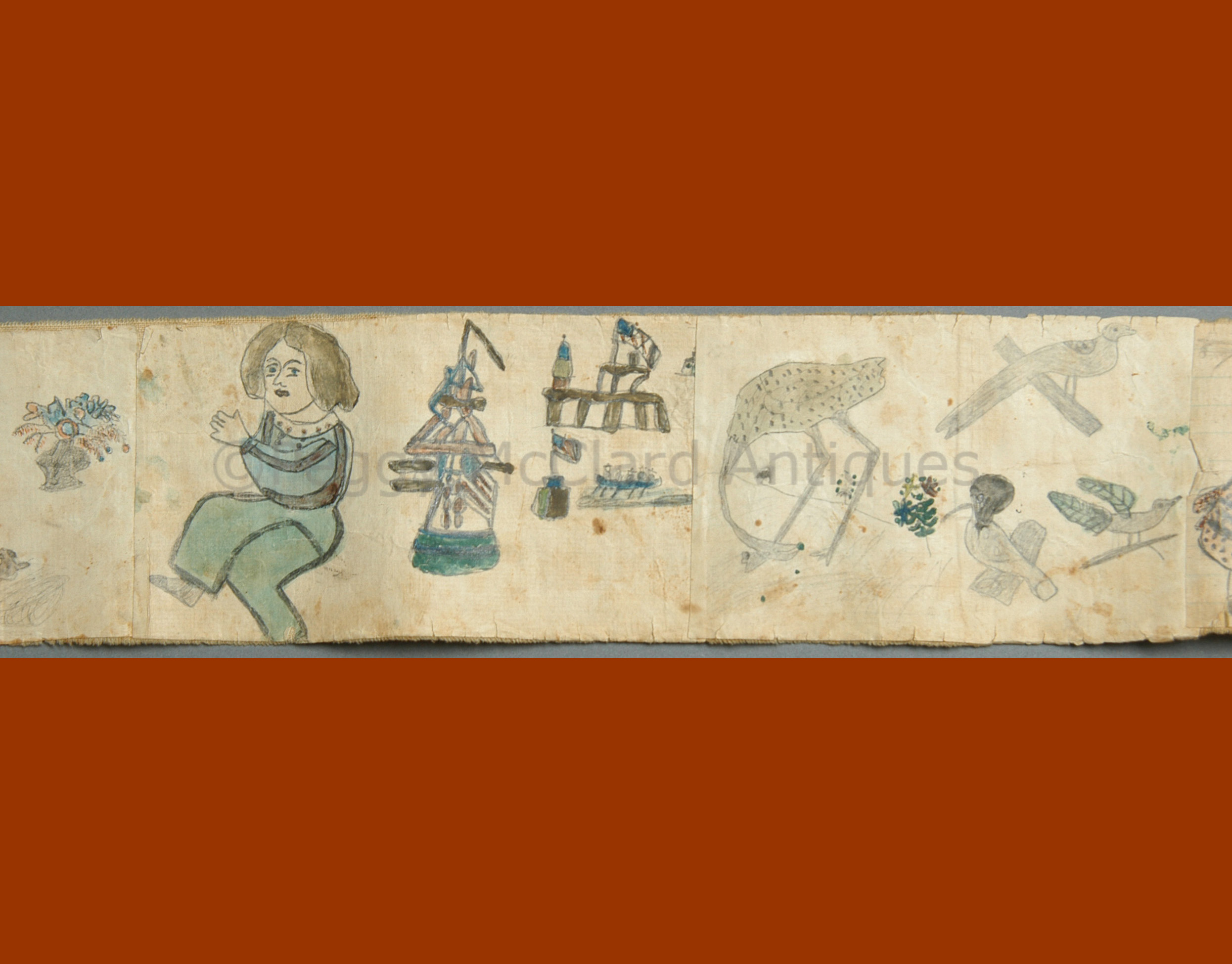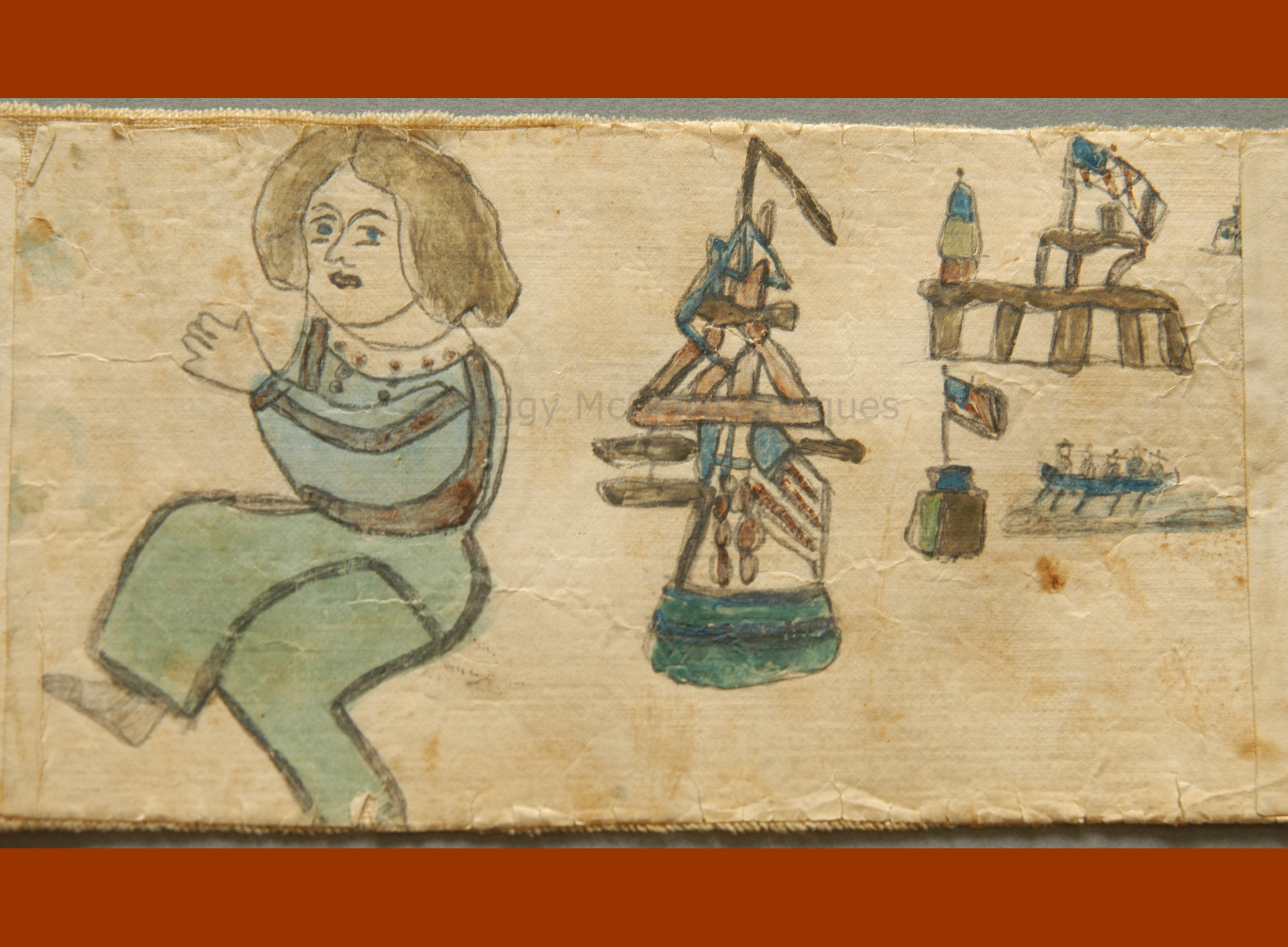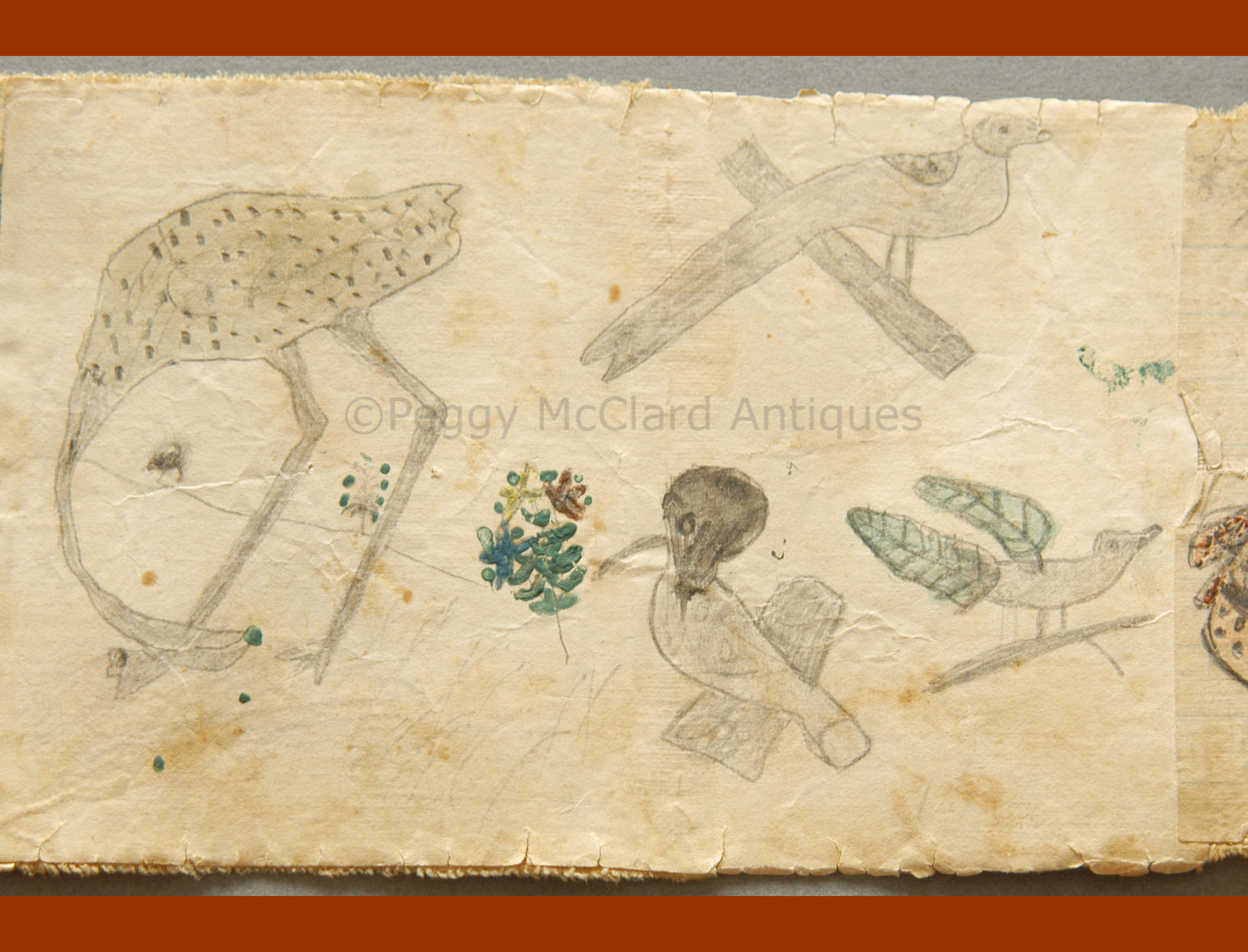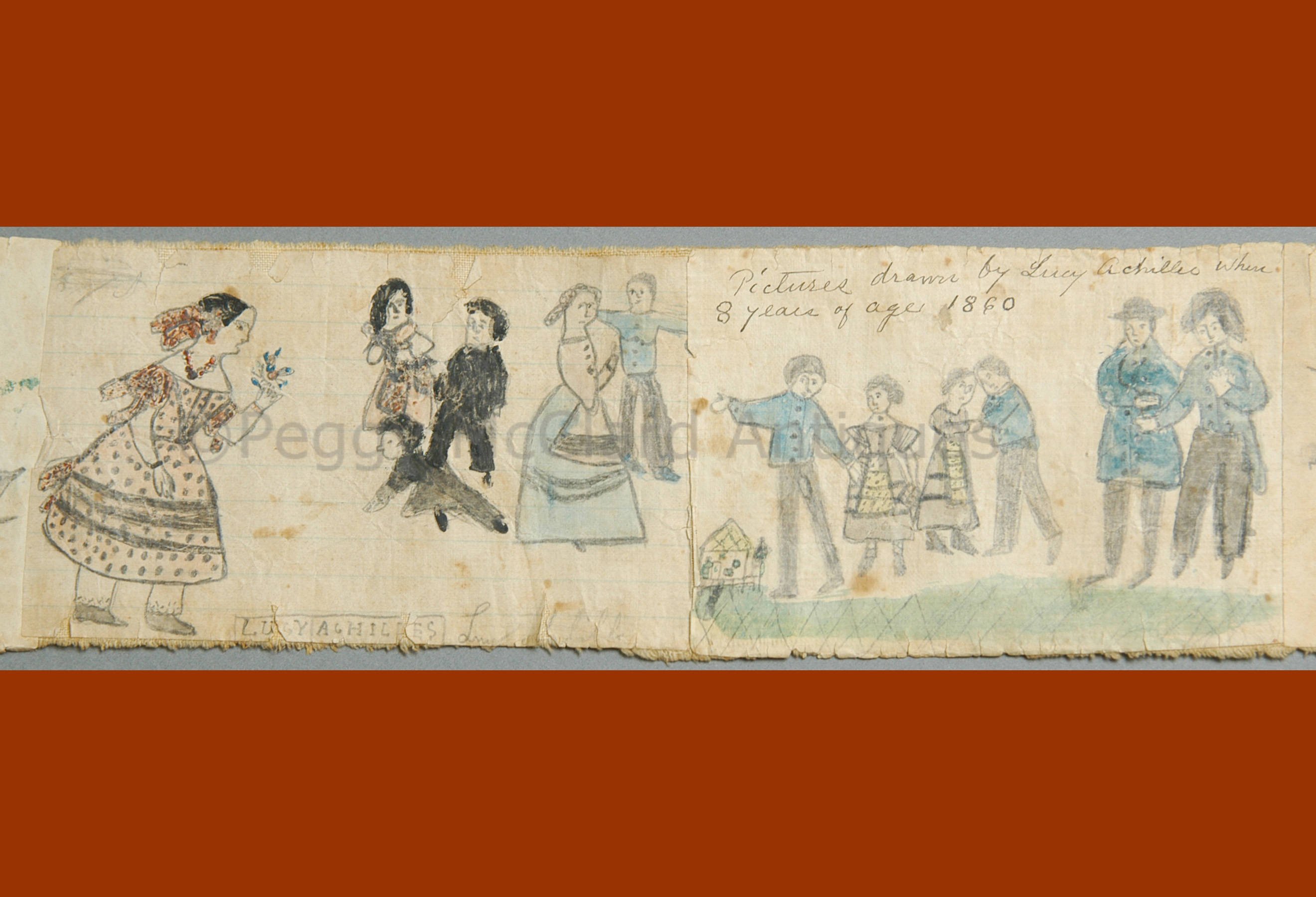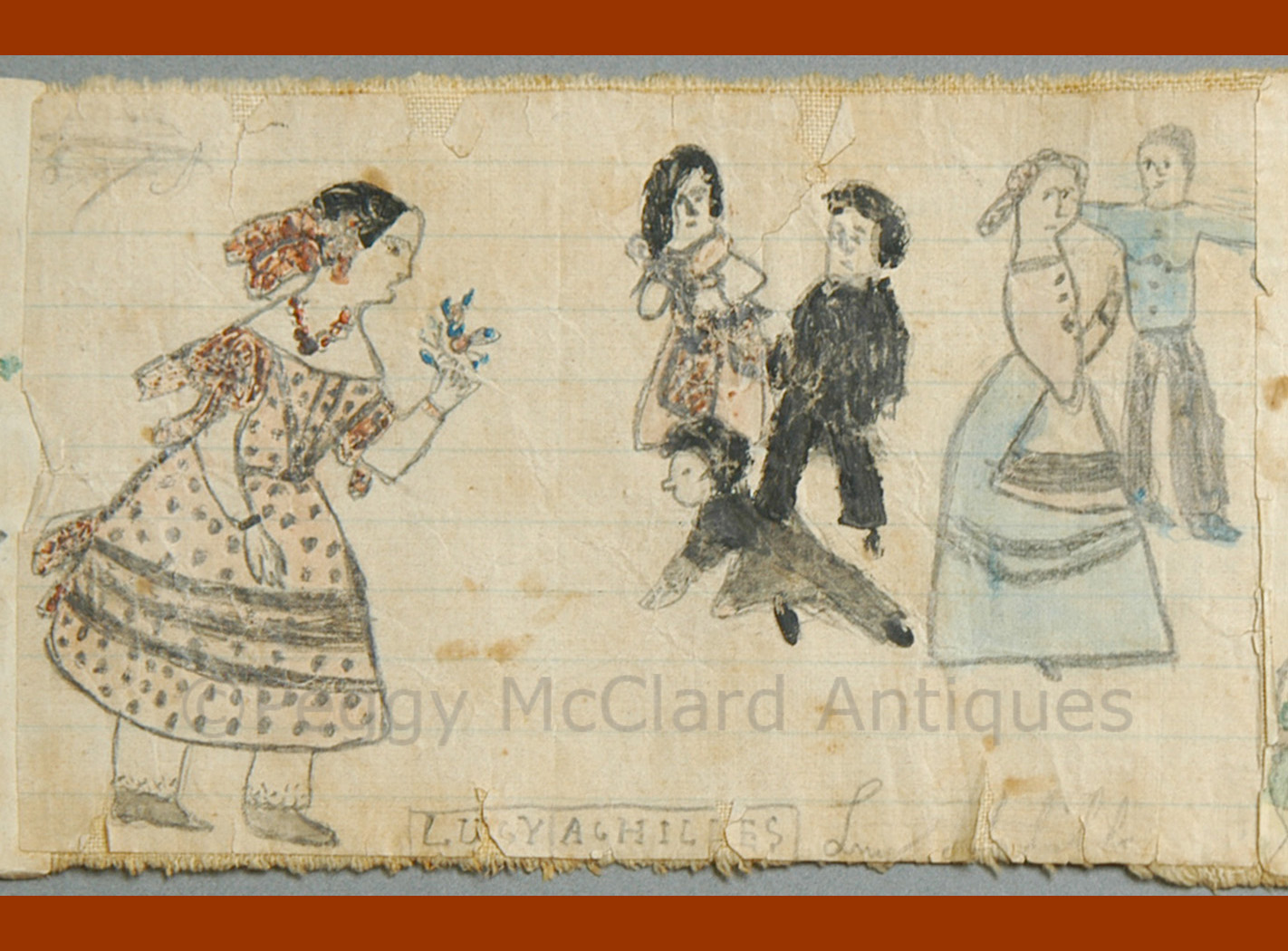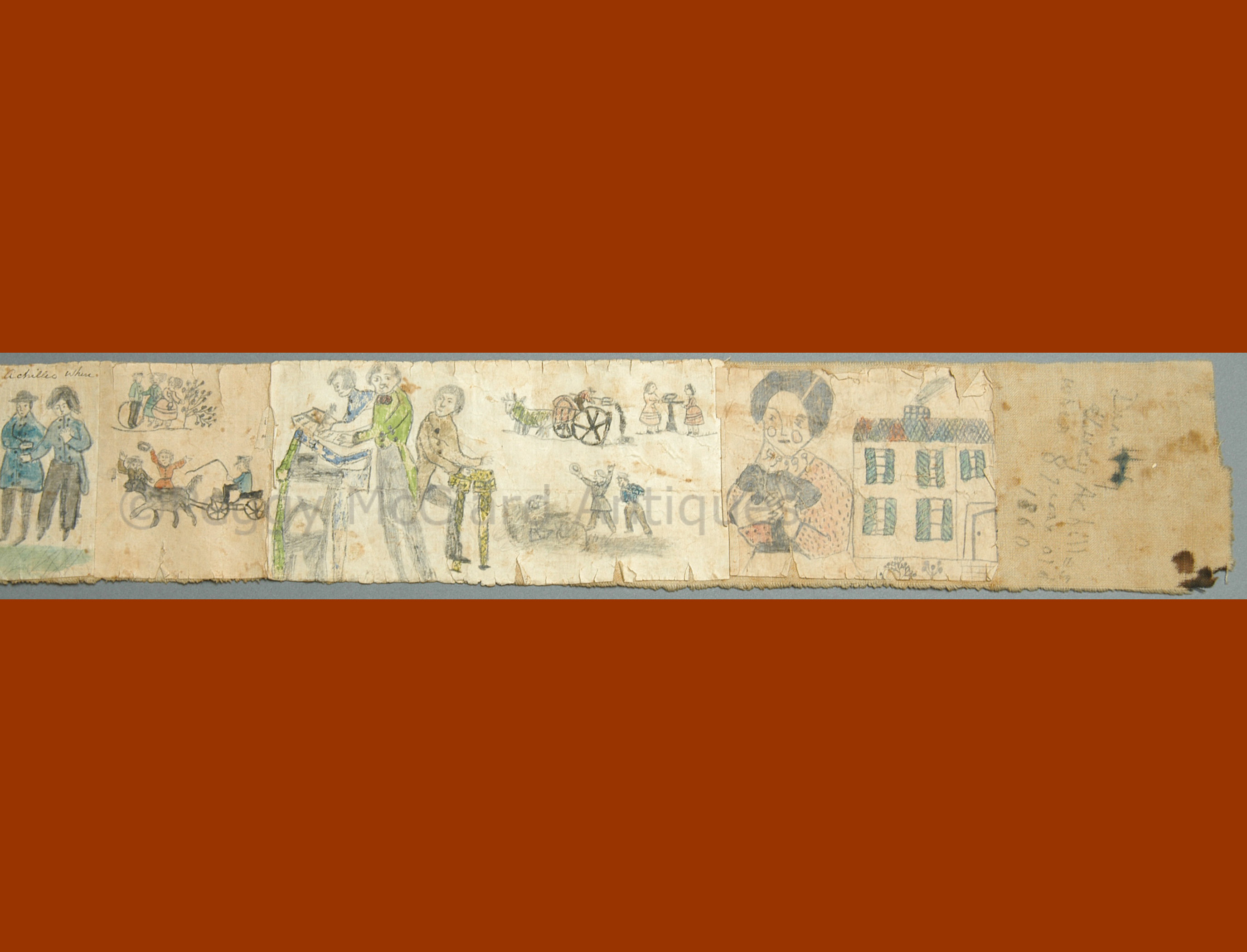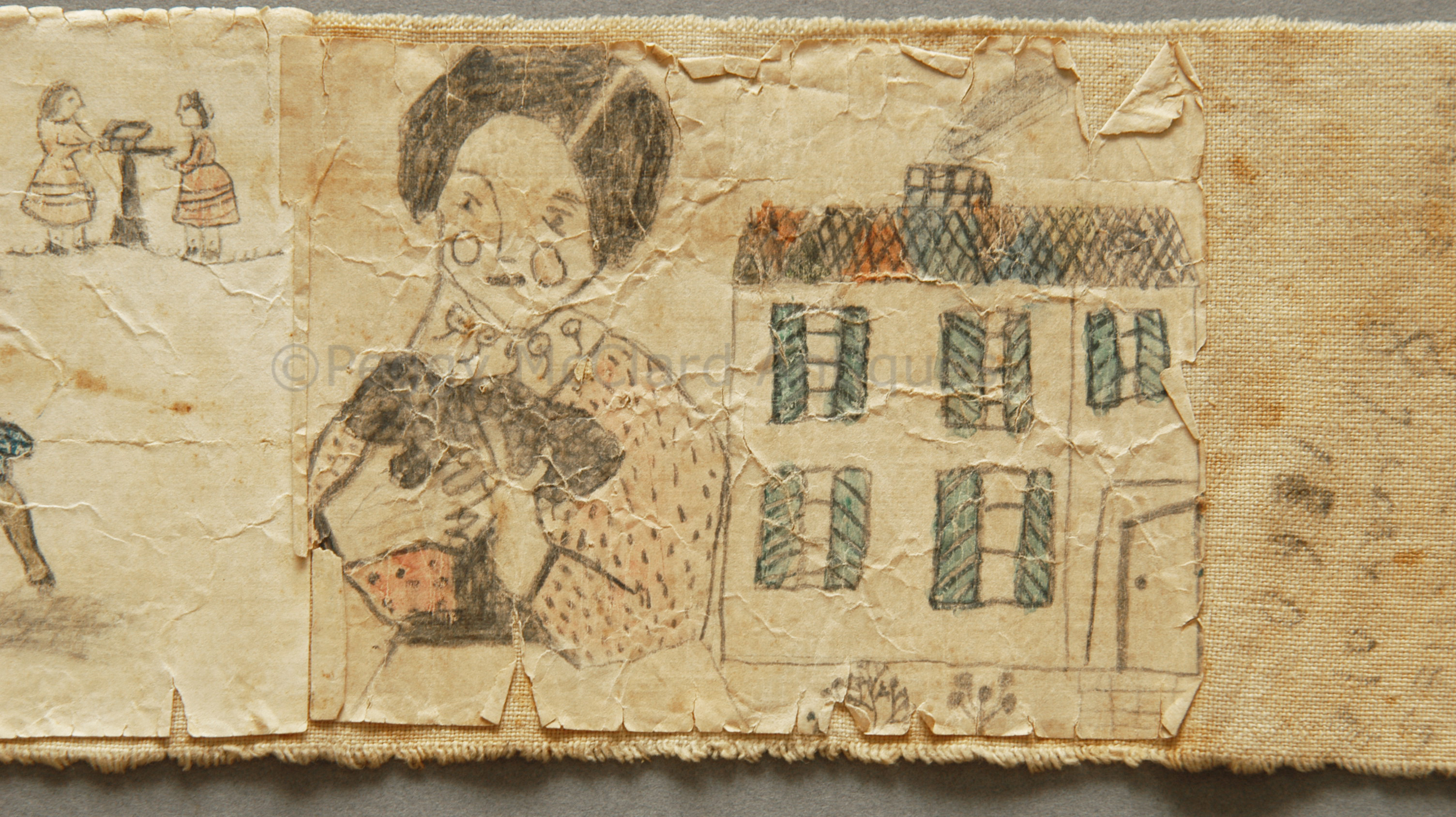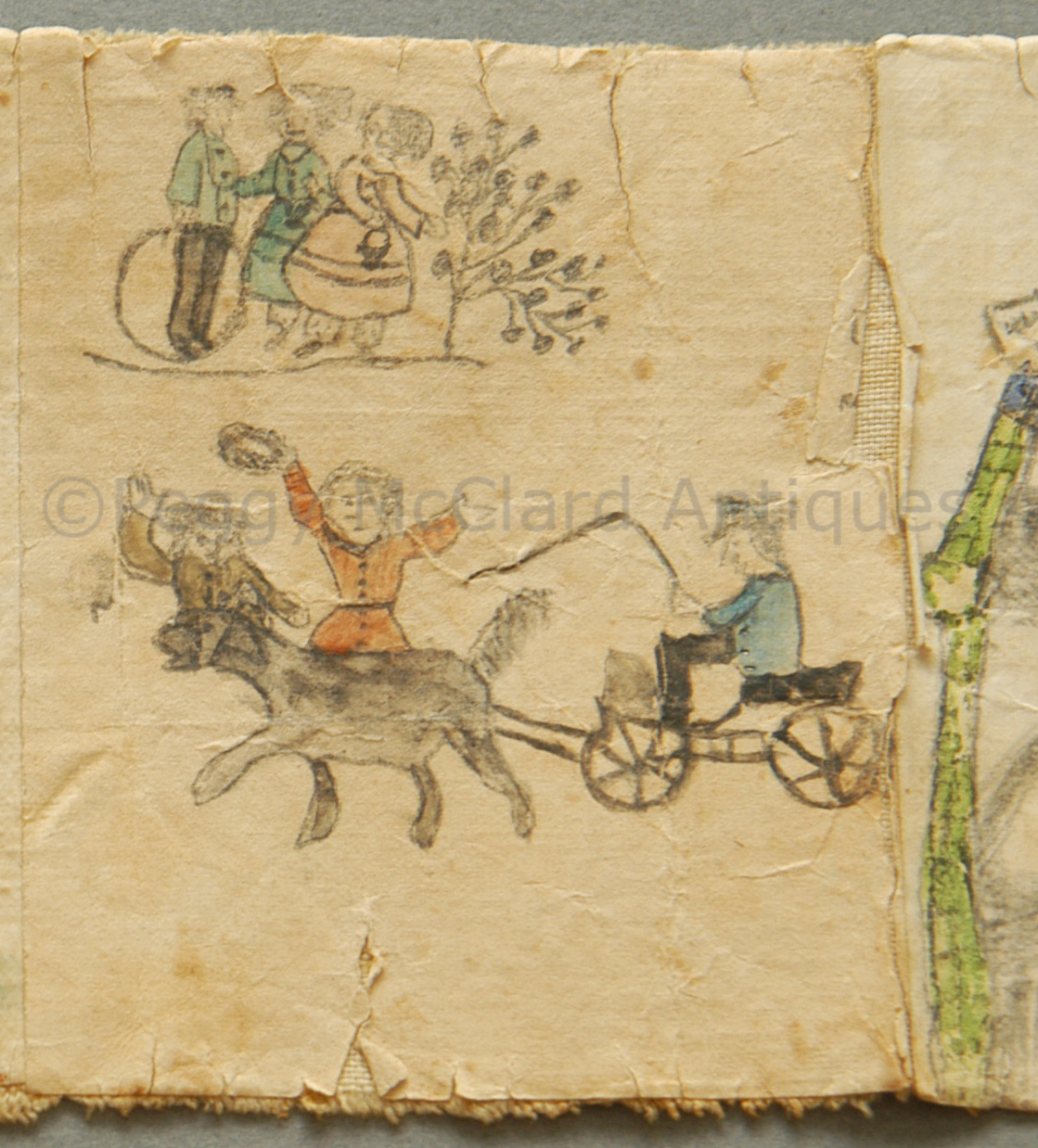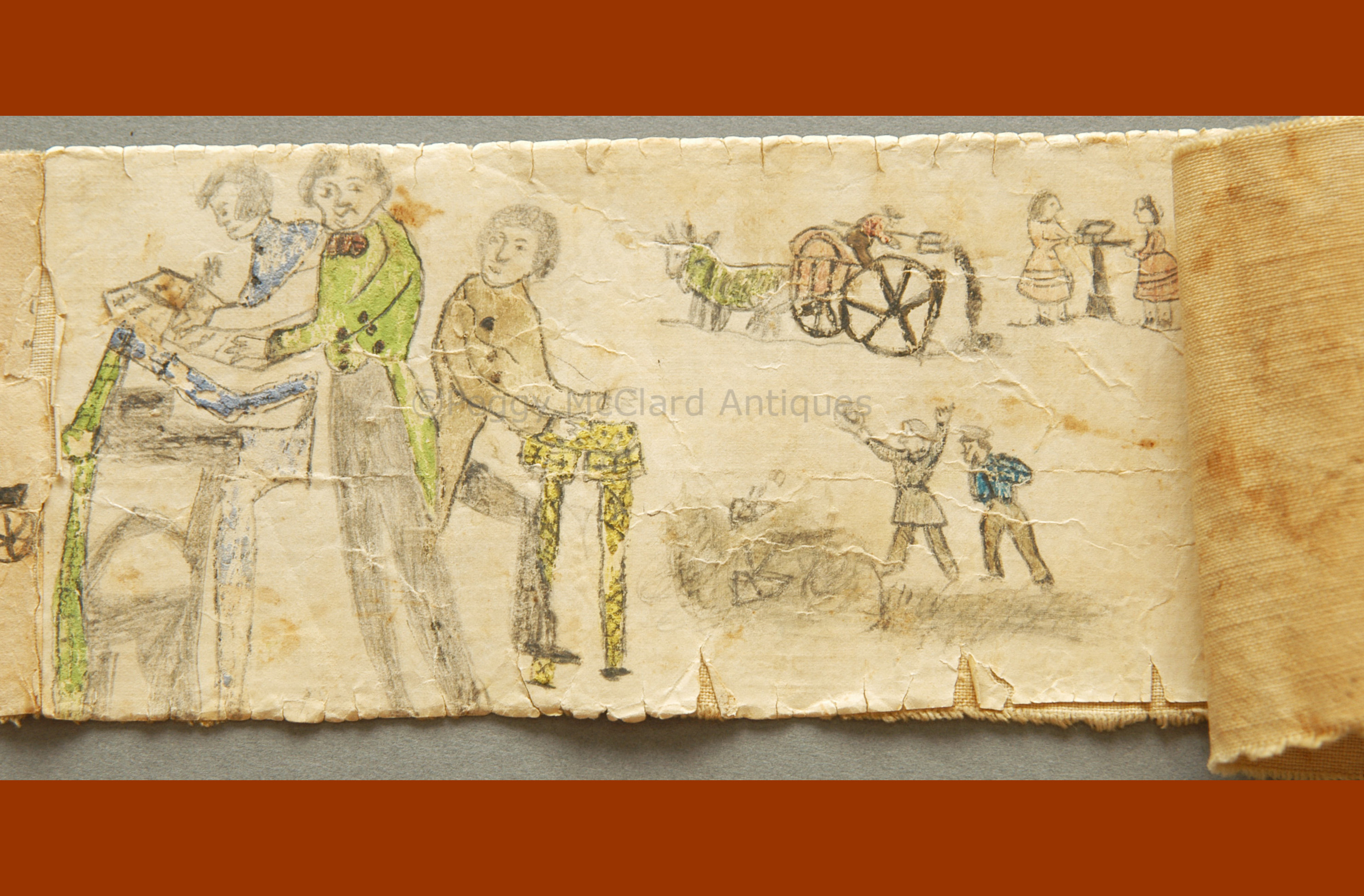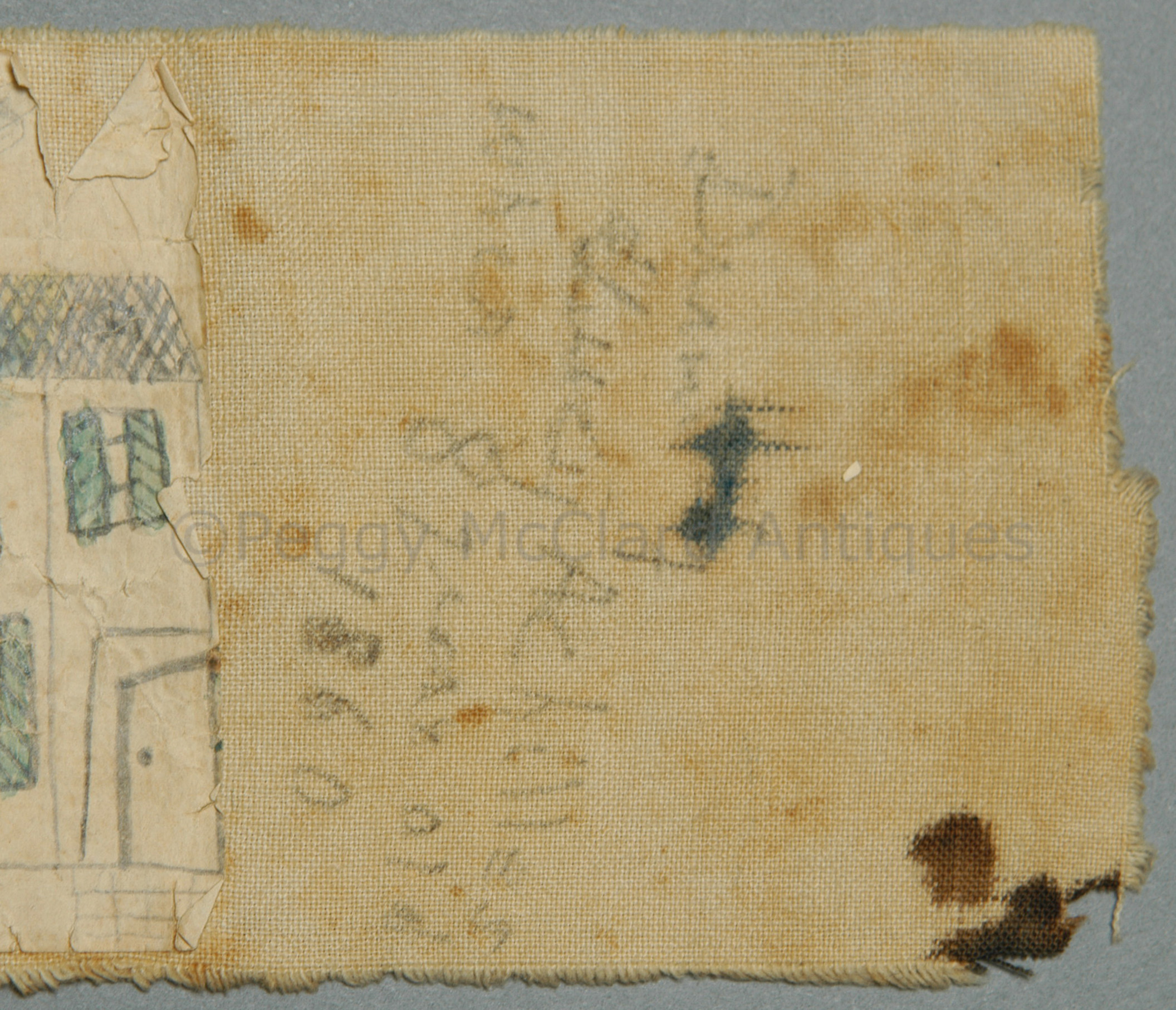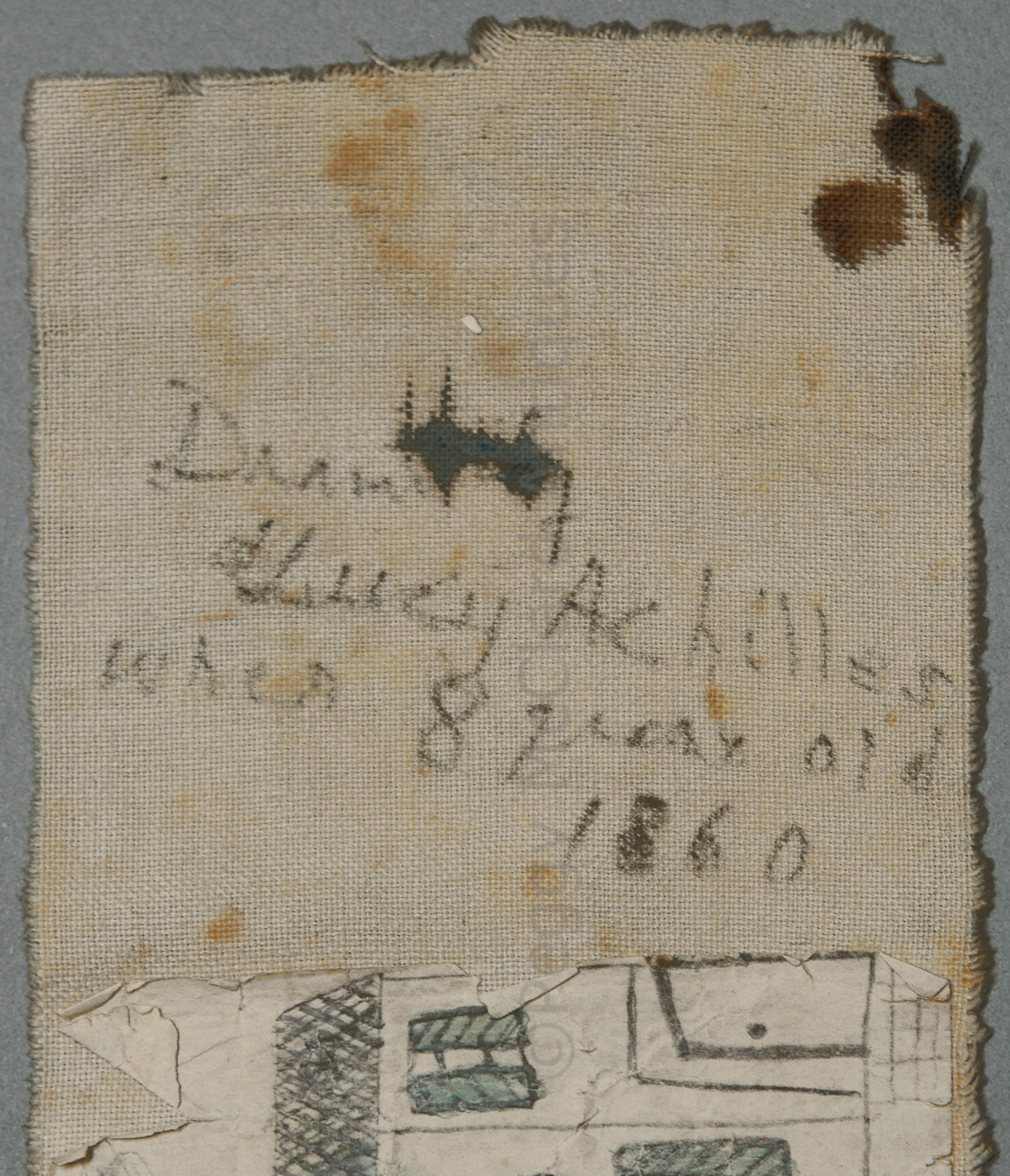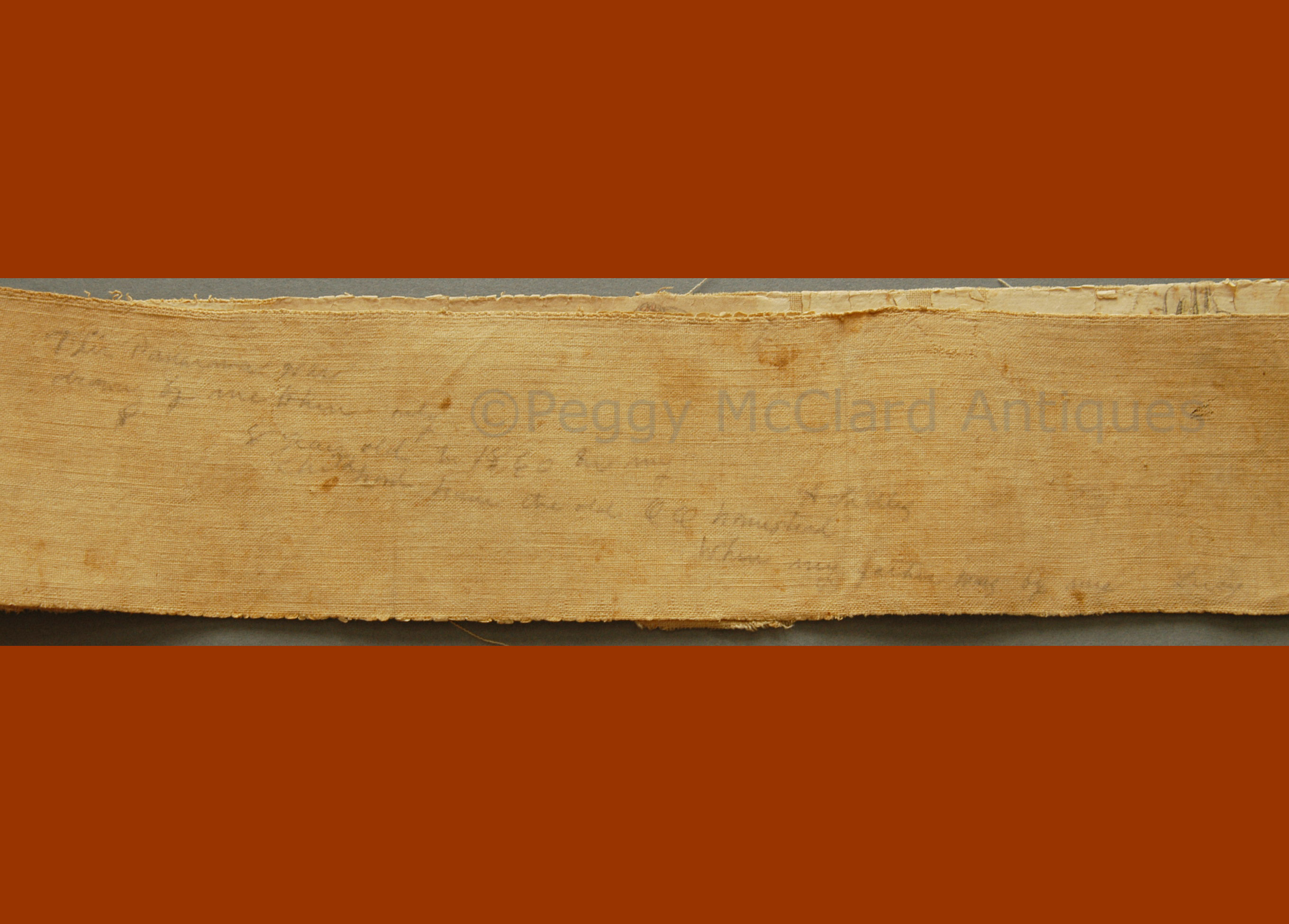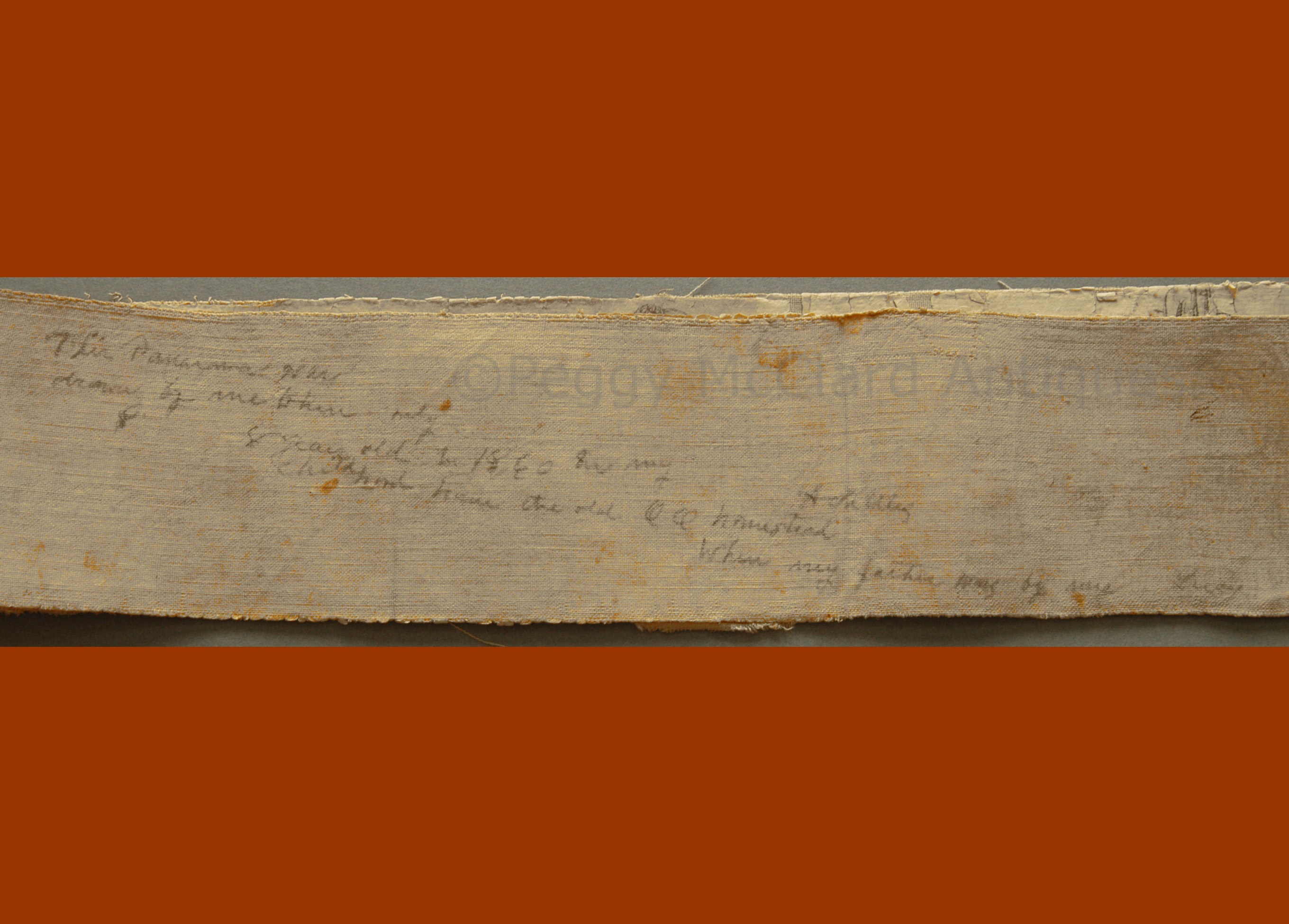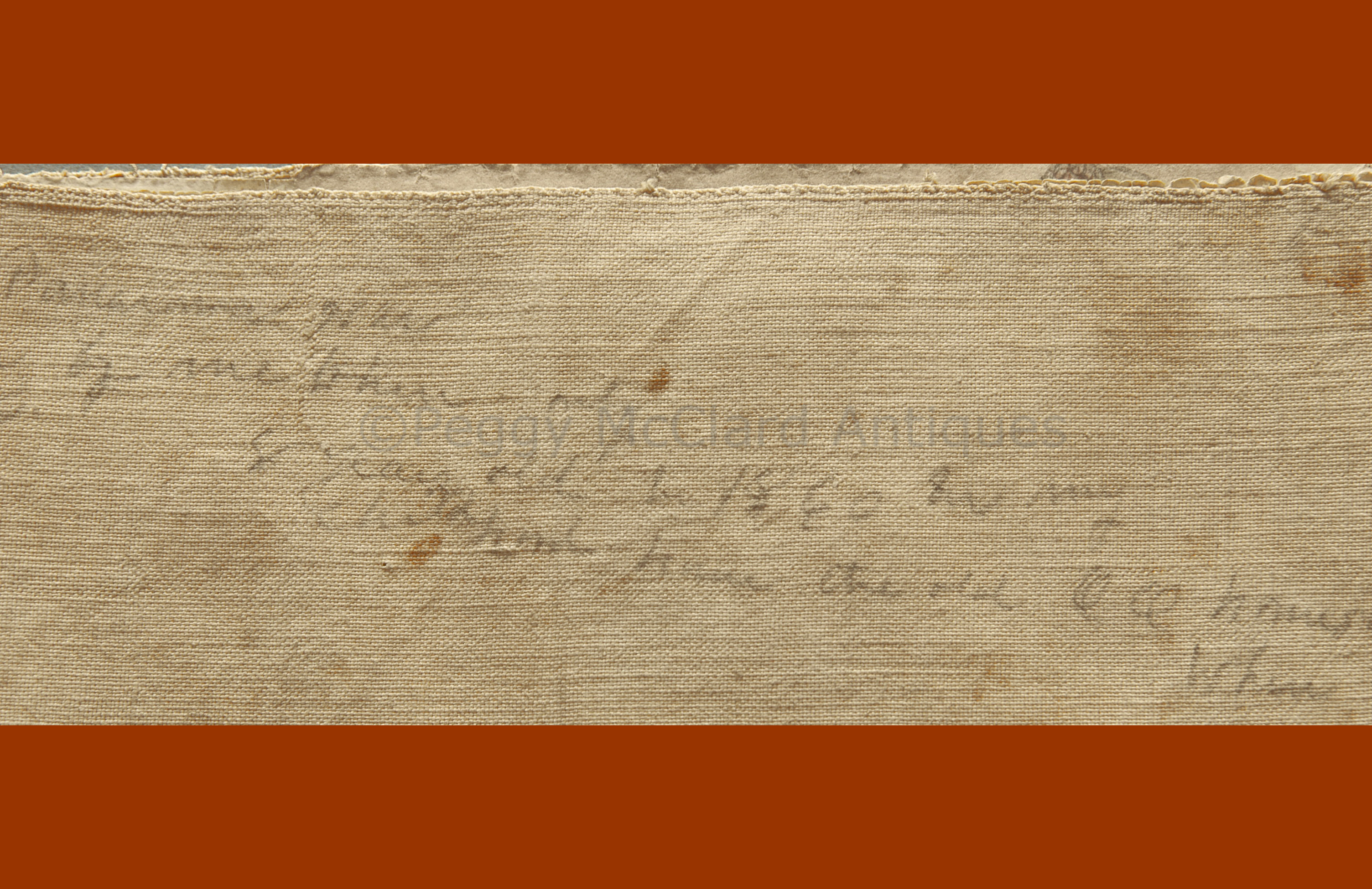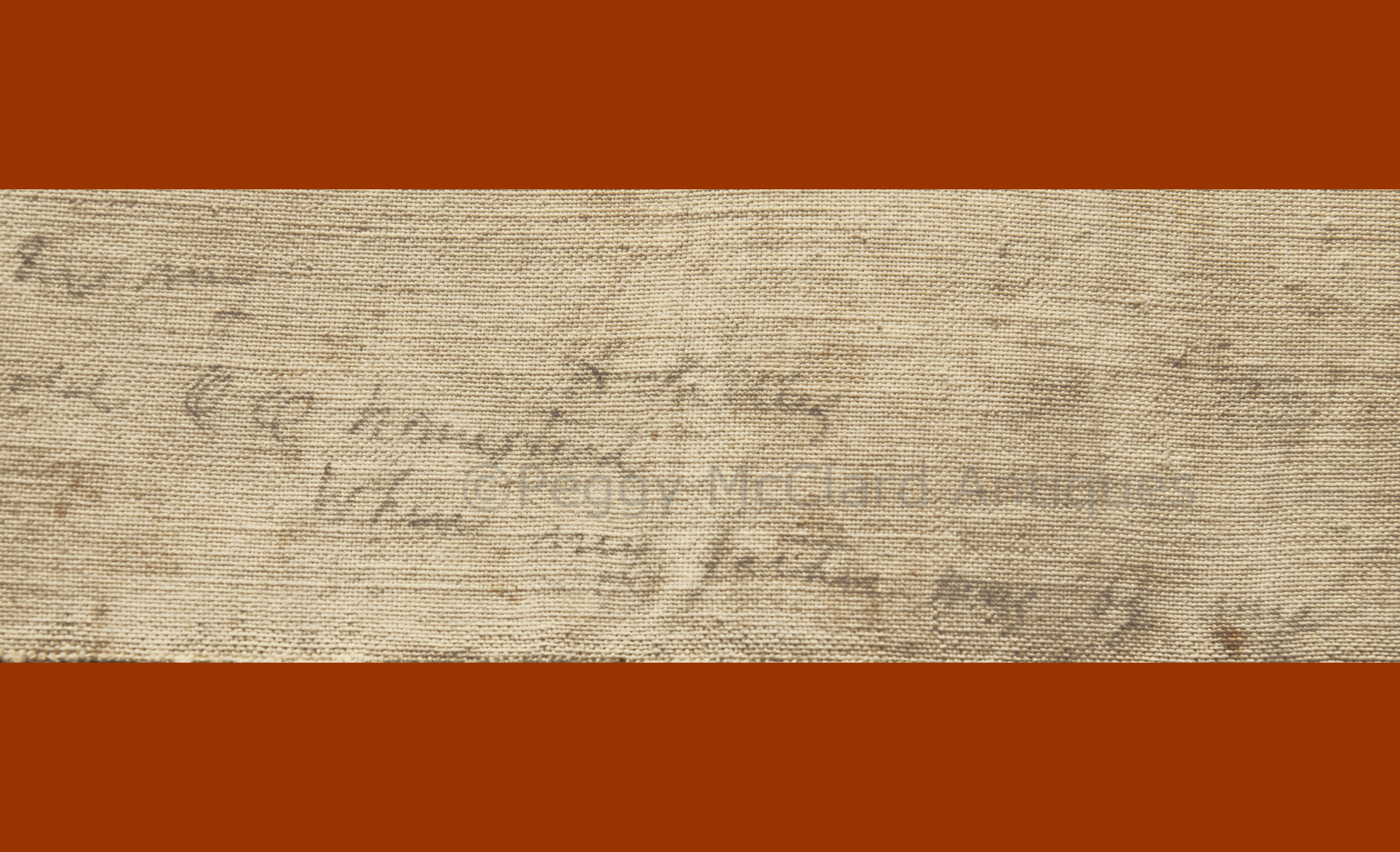
This panorama is a most amazing piece of children’s art, painted by an 8 year old child named Lucy Achilles from Ridgeway, New York (Orleans County). She signed it more than once. Her age is written in the first section along with more writing but it runs off the top edge of the paper and I can’t make out everything she wrote. Lucy also listed her age as 8 and dated the watercolor as from 1860 when, in later years she wrote a description of the piece on the back. I am assuming that Lucy painted this to illustrate her life and the life of her family and the people of Ridgeway. The painting is on 19th century lined paper and it has been glued to a continuous piece of cotton muslin so that it stretches 11' x 3 ½”.
Lucy A. Achilles was born to Morris and Diana Turner Achilles in Ridgeway, New York on October 29, 1851. Her father was a farmer, born in Madison County, NY in 1824. He died in 1860, when Lucy was 8 years old. Morris Achilles (1824-1860) was born to Alfred and Julia A Robinson Achilles. He was married to Lucy’s mother Diana Turner Achilles. Diana was born in Elba, NY to Mason and Percei Brown Turner in 1830. After several years raising her children Lucy, Fred and Jenny as a widow, she married Garrett Walt in 1869.
Online, I found a typewritten book, “The Achilles from New Hampshire, 1776-1961”, written by a family member in 1969. According to the book, Lucy was the main genealogist of one of the two main branches of the family. Her mother had started the family Bible which was remarkably updated with family history. A copy of Lucy’s written account of the U.S. branch of the family is in the collection of the New York Genealogical and Biographical Society. Lucy’s daughter-in-law donated the Bible and family records to the Swan Library of Albion NY. As we can see, Lucy’s panorama depicts her life in a prominent family of Ridgeway.
Lucy’s ancestors emigrated from Germany to New Hampshire sometime before 1779. Henry Ludwig Achilles was born in Weare, Hillsborough County, NH in 1779 and died in Gaines, Orleans County, NY about 1857. It appears that Henry Achilles was a landowner and farmer in or around New London, NH. Sometime before 1830, Henry and his family moved to Attica, Genessee County, NY. In the 1830s and 1840s, Henry and his family lived at Oak Orchard in the township of Ridgeway, Orleans County in what is described as “the handsome cobblestone house on Ridge Road”. In the 1830s Ridgeway is described as “a sporty place with a famous race course and a log tavern as the gathering place for the gaming gentry of the rising towns of Rochester, Buffalo, and Batavia.”
Henry’s eldest son was Alfred Achilles (1801-1841). Alfred married in Rochester, NY in 1823 and it is thought that he may have moved to pave the way for his father to move from New Hampshire to New York. In 1837, Alfred bought a small tract of land at Oak Orchard from a gentleman who would later become the father-in-law of Alfred’s oldest son Morris (Lucy’s father). When Alfred died in 1841, his brother ran the farm until Morris came of age at 17 years, five years after his father’s death. In 1847, Morris bought additional land for the purpose of building a dam in order to run a saw mill. Morris continued to add to his land purchases through the 1850s. Lucy’s father was Inspector of Elections for the First District of Orleans County and Overseer of Highways. Although we don’t know what caused Morris’ death at only 36 years old in 1860, his health must have been failing for some time. In an effort to make sure his wife, Diana Turner Achilles, kept land after his death, in 1859, Morris turned over 140 acres to his brother George who sold it back to Diana for $1 three days later. Diana continued to purchase land in 1862 and 1866 (an astonishing thing for a widow in those days). In 1868, she remarried to Garret Welt, a widowed farmer in Oak Orchard.
Lucy was educated at the Phipps Union Seminary at Albion, founded and directed by family members. In 1870, Lucy married William R. Kenyon of the same Orleans County, New York. William Kenyon was a farmer, and member of the Odd Fellows the Good Templar. Together Lucy and William had three children: Minnie Kenyon (born 1871), Fred Hale Kenyon (born 1875), and Frank William Kenyon (born 1878). Lucy Achilles Kenyon died September 8, 1943 and is buried in Bates Road Cemetery, Ridgeway, Orleans County, NY. Her parents, step-father and husband are also buried there.
As an adult, Lucy wrote on the back of her panorama her description which helps us identify it today. She wrote, “This Panorama was drawn by me when only 8 years old in 1860 in my childhood home the old __ __ homestead. When my father was by me Lucy”. She must have worked on the watercolor while her father was ill because he died in 1860. Perhaps she painted it to help amuse him during his illness.
In this amazing artwork Lucy has included what appears to be people in mourning; a cat drinking milk from a pan and someone named “Samuel” kneeling in prayer. I have been unable to discover the identity of Samuel, but he was definitely not one of Lucy’s siblings. Lucy also included small fanciful paintings that include a horse and rider near a person riding an animal while standing on it (the animals in this section may be horses but they appear to be more like saddled cows to me—especially so close to the more identifiable figure of the horse); a building with no visible roof, but green columns with a man in front in some activity that I can’t identify; a pocket watch with too many numbers; a man shoveling coal into a coal stove; two men in blue coats with a stick or board between them, hoisted on their shoulders to help bear the weight of something in a bucket; and a train engine pulling what appear to be coal cars. A woman in a red dress, black shawl and red bonnet is depicted (perhaps Lucy’s mother, Diana). In smaller pictures we see the same woman going about her daily activities, including tending to a bedridden person (perhaps Morris Achilles); serving food; and sitting in a chair with what I believe to be sewing while a man sits across from her with his hat hanging on the back of his chair. One panel shows a couple tending plants and a young girl with a doll standing between them. Perhaps this is her parents before her father as she remembers him before he fell ill.
Lucy included two officers with a bicorne hats, one of whom she identified as “General Scott”. Two small pictures show a boy and girl sailing a small boat while a dog bows playfully at their side and, below, a child kneeling for prayers at bedside. Lucy has written an inscription here that is faded and hard to read. I’ve included a computer enhanced photo—it goes something like “the ____ best a sister ____ And see my [thy?] pretty boat See how proud she spreads her sail”.
One panel shows a woman seated at a table while a man leans over, embracing her. The woman is so shocked that she has flipped the cricket stool at her feet and dropped things on the floor. In the same scene, a little girl stands in the foreground looking away from the scene. This scene makes me wonder whether a man made an inappropriate pass at Diana during Morris’ illness. We also see a woman who appears to see what is happening and looks a bit shocked. There are flower baskets; a girl taking a yellow bird out of its cage while a dog or cat watches; fanciful birds and animals; a woman with some kind of contraption that we have concluded has something to do with laundry; a woman playing piano for a gentleman who doesn’t look terribly interested; a couple and child at a fair; apple picking; a goat cart; a very large, columned home (is this the old homestead?); children playing; American ships and an American fort; men doing book work; a man tossing hay from the back of an oxcart; a woman holding what appears to be a cat; and a house with a center chimney. Lucy wrote her ABCs at the bottom of one panel and a line of music at the top. I have not listed everything depicted in the panorama as it is too much for the listing! It is a wonderfully fascinating look at mid-19th century life through the eyes of an 8-year old.
Condition is really very good for the age and the fact that it was a plaything. The paper is glued to cotton muslin and has developed a soft patina from being rolled and unrolled. The paper is not brittle, but there are a few losses at the tops, bottoms and seams. The watercolor and graphite has fading although the watercolor in many panels remains very vibrant (the pencil is faded everywhere). The muslin is yellowed with staining but is very strong. The muslin is cut in very long panels (surely the width of the bolt) and stitched together with long basting stitches of a child. The seam between two panels lost most of its stitching and has been pinned. The paper was obviously glued on after stitching and the muslin has really helped preserve the entire piece.
This is a phenomenal piece of folk art. I think it should be displayed as a scroll, partially showing and partially rolled on each side from two wooden scroll rods. I’m trying to have a pair sent that will work….or I may enlist Randy to make a pair. If displayed as I suggest, it can be reset every now and then to move some back into preserving darkness while a different section is displayed.
#5717 $6750

